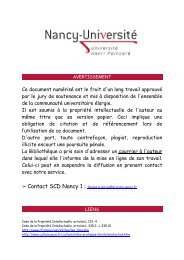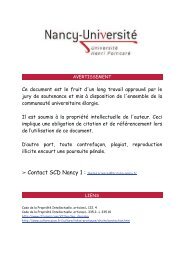La dystocie cervicale et la stagnation de la dilatation
La dystocie cervicale et la stagnation de la dilatation
La dystocie cervicale et la stagnation de la dilatation
Create successful ePaper yourself
Turn your PDF publications into a flip-book with our unique Google optimized e-Paper software.
Dans 57 % <strong>de</strong>s cas, le spasme du col cè<strong>de</strong> aux traitements. Les indications <strong>de</strong><br />
césarienne sont :<br />
<strong>La</strong> <strong>stagnation</strong> <strong>de</strong> <strong>la</strong> di<strong>la</strong>tation (27 %).<br />
L’altération du rythme cardiaque fœtal (3 %).<br />
<strong>La</strong> <strong>stagnation</strong> <strong>de</strong> <strong>la</strong> di<strong>la</strong>tation associée à une altération du rythme cardiaque fœtal<br />
(13 %).<br />
Au total, on a donc 40 % d’échec <strong>de</strong>s traitements. Dans 3 % <strong>de</strong>s cas on ne peut rien<br />
conclure concernant l’impact du traitement car <strong>la</strong> césarienne a été réalisée pour<br />
altération du RCF.<br />
59
















